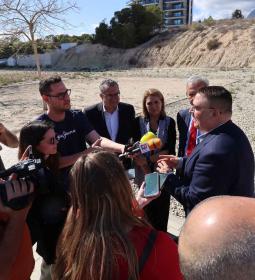The study, applicable to new plants and rehabilitation, concludes that the model is viable and also profitable if solar and wind energy generation is combined with storage
A study by the UA and Grupo TM confirms that it is feasible to build an energy-self-sufficient building in Benidorm

Building an energy-self-sufficient building in Benidorm is possible, according to the conclusions of a study carried out in the Poniente region by the University of Alicante and the R&D&I department of the TM Group, which sought to determine the potential of high-altitude wind energy.
The mayor, Toni Pérez; the vice-rector of the UA, Salvador Ivorra; and Cristóbal Ruiz, director of Urban Planning at TM Grupo Inmobiliario, presented the results of this study today at a press conference also attended by the Councillor for Urban Planning, Lourdes Caselles; the professor of Regional Geographic Analysis at the University of Alicante, Jorge Olcina; and José Luis Camarasa, who served as City Hall architect for decades.
Toni Pérez indicated that the City Council intended to deepen knowledge about the energy potential offered by wind power in Benidorm, taking into account "our high-altitude urban planning model." As part of Benidorm's commitment to strengthening its environmental sustainability, he noted, "we were seeking to confirm the possibility of energy sovereignty," and thanks to this study, "we know that wind allows us to have energy autonomy and security," at least in buildings.
Thus, according to the TM Director of Urban Planning, the study yields "very clear" conclusions for future planning: self-sufficient buildings using solar and wind energy are both "feasible" and "economically viable," with payback periods ranging from seven years for photovoltaic panels to 12 years for wind systems. Ruiz indicated that the study, which is "scalable" and replicable, proposes different solutions that, when combined, allow for progress in energy autonomy and security.
A statement echoed by all participants in the presentation, with Jorge Olcina stating that "Benidorm is once again a pioneer" and "an example to follow," in this case by proposing a construction model that advances the sustainability of its urban planning model by promoting energy sovereignty.
On this point, the professor noted that the province of Alicante "has a guarantee from the sun" in terms of energy, but "wind power has been exploited less and it is time to promote it," incorporating "wind turbines in buildings."
Study methodology and conclusions
Regarding the study's methodology, the UA vice-rector explained that the study was carried out between May 2021 and January of this year. The first phase of the project consisted of installing three anemometers at different points in Poniente, one at ground level and the other two on the roofs of the Sunset Cliffs and InTempo buildings, above 100 meters. The measurements taken in this phase made it possible to determine the average and maximum wind speeds every 10 minutes throughout the entire period analysed, as well as the wind direction. Ivorra indicated that the measurements taken over four years confirm that "maximum wind speeds are repeated annually in certain periods with certain orientations."
Based on the measurement data, it was possible to determine the energy available at a height of 100 meters and enter the second phase of the study, which must determine the feasibility and profitability of constructing an energy self-sufficient building. The former municipal architect explained that throughout the study, various energy generation systems, including turbines and wind turbines, were tested and proposed for a typical 100-meter building. Construction solutions that could facilitate this were analysed, such as "rounding the cornices" and "making the buildings slimmer." These premises, according to Camarasa, will be observed in "the planning of the Levante Extension."
He explained that the various tests and measurements show that with the combination of "solar and wind energy we would have a surplus for the building's operation. However, when addressing self-sufficiency, in addition to production, we must also consider "consumption, which is not homogeneous." Therefore, "there are times when you have excess energy and times when you lack it, and that's where energy storage comes in," which is essential to guarantee energy autonomy.
He added that this installation "would not only allow the building to be self-sufficient, with the resulting energy and economic savings, but would also allow it to continue operating in the event of a power outage like the one last April."





